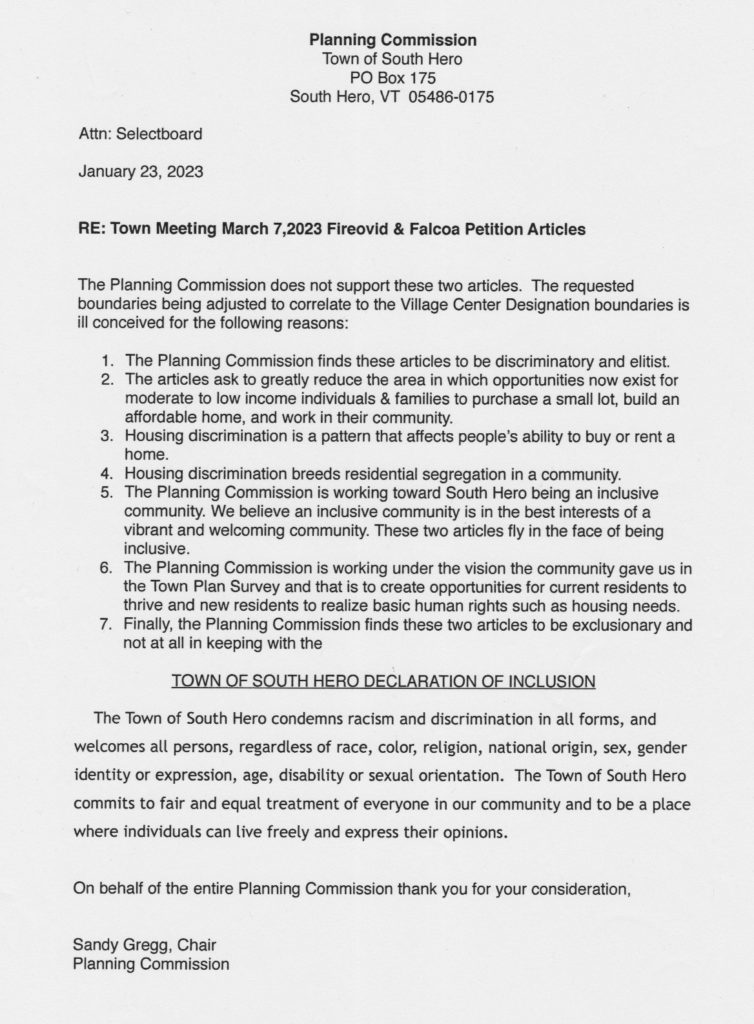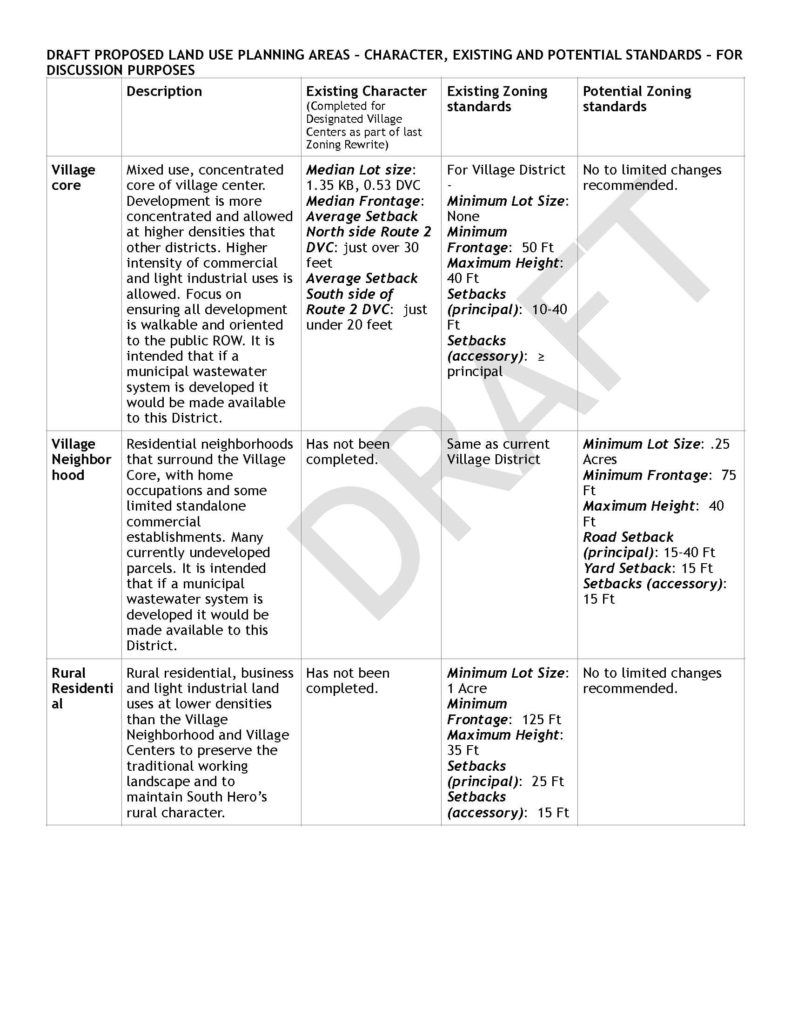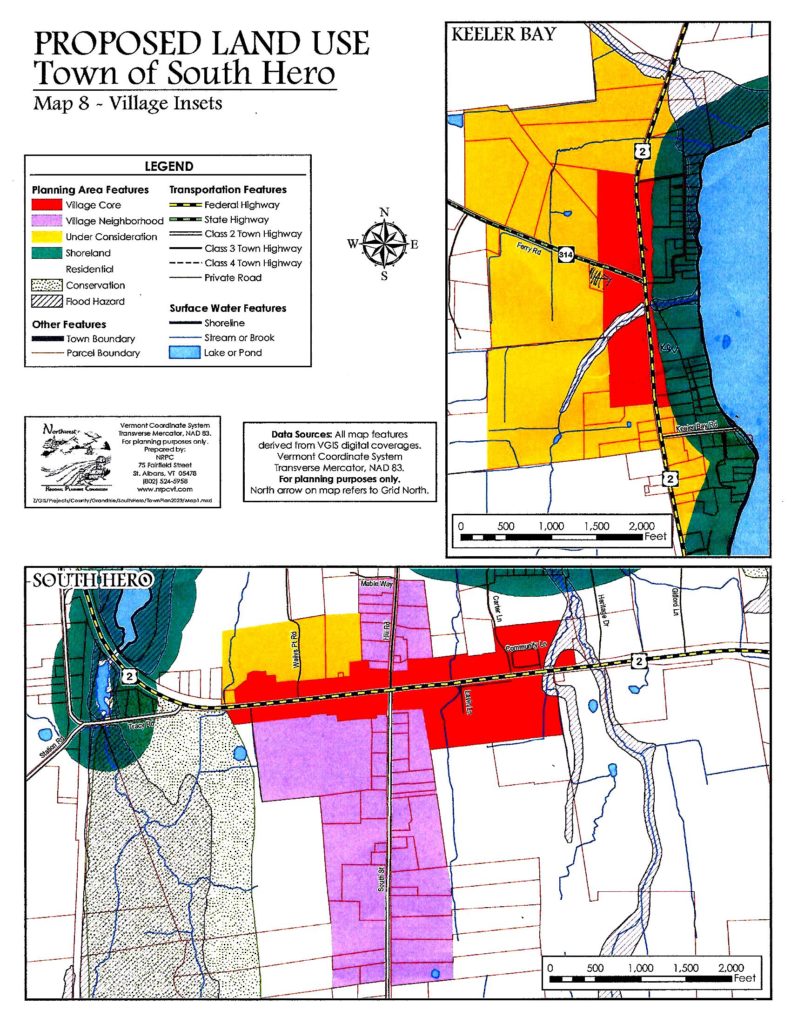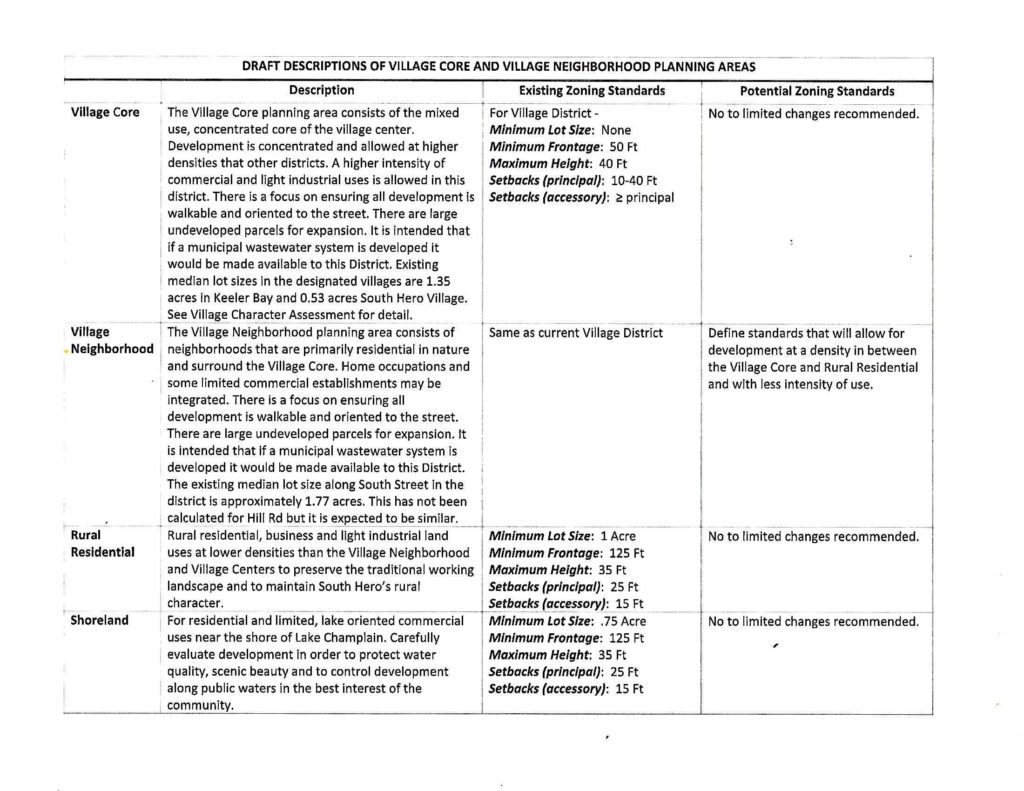This letter was presented by chair Sandy Gregg at the Selectboard meeting of 1/23/2023, after the Selectboard had voted to place the articles on the upcoming ballot at Town Meeting.

This letter was presented by chair Sandy Gregg at the Selectboard meeting of 1/23/2023, after the Selectboard had voted to place the articles on the upcoming ballot at Town Meeting.

A detailed and very readable article about the citizen petition was published in the Jan 11-17 issue of The Islander.
The article reported that the Selectboard questioned whether the ballot questions requested by the citizen petition were “binding” or merely “advisory.” A binding question is one that must be on the ballot at town meeting. Unfortunately, the article did not present the strong evidence in support of the view that the petition is indeed binding.
Here’s an explanation from the Vermont League of Cities & Towns about what makes a petition “binding” (https://www.vlct.org/voter-backed-petitions-faqs)…
[Q:] If a petition asks for a vote at the annual town meeting, is the selectboard required to place that article on the annual town meeting warning?
Yes, but only if:
The petition specifically cites a section of Vermont Statute 24 V.S.A. § 4441 which gives voters in South Hero the authority to vote on the two requested articles articles .
Two days after the January 9 Selectboard meeting, a letter was sent to members of the Selectboard and Planning Commission explaining why the ballot questions requested in the Dec’22 citizen petition are binding. Here is a link to a copy of the letter…
For the Planning Commission’s ZOOM-only meeting tonight, the following potential zoning standards will be under discussion. Please note that the proposed Village Core has no minimum lot size and that the proposed Village Neighborhood has a 1/4 acre minimum lot size.


The December 21, 2022 presentation by Greta Brunswick of the Northwest Regional Planning Commission to the South Hero Planning Commission was encouraging. There was an acknowledgment that the shoreland area of the Village Zoning Districts should not be in the village core, which is currently zoned for dense development. Also, a new Village Neighborhood zoning district was proposed for Hill Road and South Street, and parts of both South Hero and Keeler Bay Village Zoning Districts now appear to be “under consideration” for modification. This is all up for discussion at the next Planning Commission meeting, scheduled for January 4, 2023, at 6 pm. Click here to see the PC meeting agenda.
We hope to see you there, but if not, we’ll report on it. Happy New Year to all!
Here are the DRAFT maps with descriptions presented at the December 21 Planning Commission meeting, which will be the basis for discussion at the next meeting on January 4.


After many residents in the Village Zoning Districts (VZDs) expressed opposition to the size of the VZDs (see survey results) and after the Planning Commission declined to address this opposition in any meaningful way, a petition was circulated to modify the Town’s zoning regulations so as to decrease the size of the VZDs (see petition).
The petition, with 113 signatures of verified voters, was submitted to the Town Clerk on December 14, 2022.
Volunteers walked the streets of the South Hero Village Zoning District and the Keeler Bay Village Zoning District to ask residents how they felt about the planned density for their neighborhoods. Volunteers spoke to those who were home or those who were absent but who called the survey taker, based on a little note left on their door. Residents of the Village Zoning District (VZD) were encouraged to come to the visioning meeting held by the Planning Commission at the Worthen Library on September 7, 2002.
Click here for a copy of the South Hero VZD-resident survey by volunteers (a similar survey was used for the residents in the Keeler Bay VZD).** 57 surveys were completed, which is more than twice the number of VZD-resident responses that the Planning Commission reported receiving to its online survey. And different questions were asked in the in-person survey — that is, questions specific to the recent 2020 zoning changes which uniquely affected VZD residents.
Click here to view the anonymous summary results. Overwhelmingly, survey respondents do not want the new zoning regulations that promote dense development in their neighborhoods. And most of them were surprised that their homes were in the village zoning district. Multiple survey respondents voiced unsolicited concern that the new zoning requirements should have been put on a ballot for voter approval.
** note: Additional questions were added to the survey, as new issues became apparent; e.g., maximum building heights and minimum green space requirements.
There’s lots of activity to report on creating the 2023-2031 South Hero town plan!
The town’s Planning Commission, with the support of Northwest Regional Planning Commission (NRPC), conducted a survey of residents about their vision for South Hero. There were 207 respondents and the survey results are presented here. Emily Klofft of NRPC summarized the survey results in a very readable format with helpful graphs and charts, as well as background information. All the survey comments are presented, along with categories assigned to the elements of the comments as well as summaries/analysis of the categories.
The web page for the town plan, hosted at NRPC, outlines the overall planning process. And a list of outreach and engagements activities already completed can be found here.
On September 7, the Planning Commission held a public meeting at the Worthen Library to refine a vision for South Hero’s two Village Zoning Districts. The power point presentation can be downloaded here. And the draft minutes of the meeting are also posted here on the town website.
This Visioning Workshop had been advertised on Front Porch Forum as the place for answers and discussion. But when Joan Falcao asked how the current village boundaries were determined, Greta Brunswick of NRPC declined to answer by explaining that any future changes to the boundaries will be based on the 2023 Town Plan vision for the villages. Greta stressed that this workshop was to get the residents’ vision for what the villages can be; not for changing the current boundaries of the two villages. The Planning Commission is looking for input on the current vision and purpose.
Undeterred, George Rice, who has served on the Select Board in the past, commented on current village district boundaries. He suggested they initially be kept small then enlarged later if needed. Phil Reynolds felt the village zone, targeted for dense development, should be closer to the designated village center (RT 2). He suggested that Planned Unit Developments should be encouraged in rural areas.
Several residents clapped in agreement when the need for expansive boundaries of the two Village Zoning Districts was questioned. Though a few in attendance appeared to be in support of no minimum lot size and decreased setbacks in areas that have been traditionally residential or agricultural or include shoreline, it is notable that the few individuals in support of expansive Village District Zoning boundaries do not live within either Village Zoning District, and based on their occupations–some stand to gain financially if the density is increased or industry is allowed beyond Routes 2 and 314 in the Village Zoning Districts.
Although zoning regulations for minimum lot sizes, property boundary setbacks and green space requirements would seem important elements of a town plan, these were explicitly excluded from the visioning process. So participants had to figure out how to communicate with NRPC about concerns around the issues of privacy and preserving green space. To some residents, these issues are much more important than curb bump-outs and pedestrian furniture; i.e., preferences which were addressed in the town survey.
One of the workshop activities was a mapping exercise where attendees broke up into 3 groups with maps of the 2 villages. Attendees were encouraged to place little wooden tokens on areas where they thought single and multifamily homes should be built, and they were also encouraged to make comments on post-it notes. So some attendees noted that they wanted fields to remain open and to remove the shoreline areas from the village zoning districts.
According to the minutes of the meeting: “Summarized comments on the mapping exercise included encouraging multi-family housing on RT 2; walkability; keep the maple trees; maintain open space; commercial development mainly on RT 2; for to fit VT characteristics; sidewalks; traditional development patterns less than 1 acre; focus on corridors to create walkable communities.”
Other comments expressed at the meeting, but not recorded in the minutes, were to avoid installing sidewalks on South Street and to go back to the one-acre minimum lot size for future subdivisions in the village zoning districts
Photos of two completed maps from one of the breakout groups are posted below.
The purpose of this website is to facilitate the ability of registered voters in South Hero and other stakeholders* to be more informed about and to provide timely input regarding decisions by their Town government.
March 1, 2022, Town Meeting: Ballot Questions (Articles) 8 and 9
The December 2021 petition to add two ballot questions to the upcoming Town Meeting was successful. It was signed by 150 voters.
Article 8
Article 8 is as follows:
Shall the Town of South Hero adopt and amend town plans by Australian ballot pursuant to 24 V.S.A. § 4385(c)?
Article 8 asks whether future Town Plans be approved by voters at a Town Meeting. As it turns out, the State requires that South Hero update its Town Plan in 2023; so this Article is very timely.
Development is a permanent change to the landscape, and a development can completely change the character of the landscape. Once a development is approved and built, it cannot be turned back, rescinded, or reversed by a Selectboard or by residents. The Town Plan is an extremely important document because a Town’s zoning districts and zoning regulations must, according to State law, be consistent with the Town Plan.
The first step in changing an unpopular zoning regulation is to make sure that the Town Plan prohibits that regulation. If something written in the Town Plan would result in a zoning regulation which a majority of voters do not want, then voters must be able to ensure that such text is not in the Town Plan. Likewise, if a zoning regulation which a majority of voters do not want would be allowed because it is NOT prohibited by the Town Plan, then voters must be able to ensure that the Town Plan expressly prohibits that unwanted zoning regulation.
Without voter oversight, development in South Hero is controlled by a simple majority of the five-member Selectboard. Three people on the Selectboard (a simple majority) can choose who will be voting members on both the Town’s Planning Commission and the Development Review Board. The Planning Commission creates both the Town Plan and the Town’s Development (zoning) Regulations, and the Development Review Board administers the application of those Regulations to proposed development plans received from property owners.
In summary, as things currently stand, only a handful of South Hero voters have effective, direct control over what development happens in South Hero. The other 1,600 or so voters can complain all they want, but they currently have no real say (i.e., they cannot vote) on what is in the Town Plan. Just three people (a majority of the Selectboard) can exercise control over our Town Plan and the Town’s land use decisions.
Passage of Article 8 will ensure that all voters have direct oversight regarding the content of future Town Plans. The privacy of the ballot box is an important tool for this purpose.
Article 9
Article 9 is as follows:
Shall the town adopt bylaws, bylaw amendments, and bylaw repeals by Australian ballot pursuant to 24 V.S.A. § 4442(c)(2)?
Article 9 asks whether changes to the Town’s development (i.e., zoning) regulations be approved by voters at a Town Meeting. The State gives this choice to voters in small, rural towns. The term “bylaws” is defined by the State as “…municipal regulations applicable to land development…” (24 V.S.A. § 4303).
This ballot question resulted from a petition after the South Hero Selectboard approved new development regulations which created two large “Village Zoning Districts” having dramatically different zoning regulations from the rest of our town. The South Hero Village Zoning District is centered roughly at the intersection of South St and Route 2 and the other area is around the intersection of Route 2 and Route 314. The South Hero Village Zoning District is about 350 acres and goes from Folsom School to Lake Champlain on the north, and from beyond Gifford Dr. on the east to IslandAcres Farm. The Keeler Bay Village Zoning District is about 285 acres and goes from Lake Champlain to beyond Eagle Camp Rd and from beyond the old site of the Champlain Islands Health Center to just south of Keeler Bay Marina.
Maps of the Village Zoning Districts are posted on the Town’s website here, and copies of these maps are accessible via links provided below.
Respondents to the SHIZAC survey supported commercial or industrial development along limited sections of Route 2 and Route 314. While this survey and the 2015 Town Plan are due for an update, survey respondents made it clear they believed residents should be able to advise boards involved with planning. Over 86% of respondents thought commercial development should be concentrated along village centers. And 72% of respondents said “No” to new commercial development along South St between Route 2 to Landon Rd.
Many of the residents in the newly created zoning districts were surprised (1) to learn that their property is in one of these village zoning districts and (2) of the new zoning regulations in them…
For the reader’s convenience, a copy of South Hero’s Development Regulations is posted here
South Hero’s Village Centers, which are areas designated by the State, are defined in South Hero’s current (2015) Town Plan. These Village Centers are much smaller than the Village Zoning Districts mentioned above and which are defined in the Town’s new Development Regulations. The Keeler Bay Village Center is only 14 acres and the South Hero Village Center is only 28 acres (maps of the Village Centers are provided below).
The current Town Plan actually proposed the village zoning districts and shows that their areas will be relatively small, i.e., identical to the areas encompassed by the Village Centers. For the reader’s convenience, copies of the relevant text and map in the Town Plan are provided here (see text highlighted in yellow).
The following maps show how much larger the Village Zoning Districts (defined in the Town’s Development Regulations) are relative to their descriptions in the 2015 Town Plan.
South Hero Village Center (from 2015 South Hero Town Plan, p.80; ~28 acres)
South Hero Village Zoning District map (August 2021 Development Regulations; ~352 acres)
Keeler Bay Village Center (from 2015 South Hero Town Plan, p.81; ~14 acres)
Keeler Bay Village Zoning District map (August 2021 Development Regulations; ~285 acres)
Because land-use decisions have major, long-term impacts on our town, we believe voters should have oversight regarding land-use decisions, just like the oversight they exercise regarding the Town’s budget. In particular, voters with property in areas directly affected by changes to zoning regulations should have an effective voice in whether they agree with such changes. If passed, Article 9 would do just that. In the future, if voters find this responsibility too onerous, they can give this responsibility away.
One concern raised about Article 9 (although this concern seems aimed at distracting our attention from the real issues) is this…
If the Planning Commission needed to make a minor change or clarification in the zoning regulations – say in May – and wanted the change/clarification to be effective ASAP, then a special Town Meeting would need to be called. Town officials estimate that a special Town Meeting would cost $2,000 – $3,200. In the grand scheme of things, this is only about $2 per voter. And considered against the risk of having zoning regulations that do not represent the will of the voters, this expense is trivial and well justified.
First, it is unlikely that any emergency situation would arise where a special Town Meeting would be necessary to quickly revise the Development Regulations (formerly Zoning Regulations). Previous major revisions to these regulations in 1978 and 2009 were well written and were approved by the town’s registered voters at regular annual Town Meetings in those years. The existing, completely rewritten Development Regulations were approved in March 2020 and revised September 13, 2021. So presumably the document has been “debugged”, and certainly all known problems have been corrected.
Existing structure or uses that do not meet the current Development Regulations are simply defined as “nonconforming” and are allowed to continue, so there would be no motivation to hold a special Town Meeting if they were affected by any errors or inconsistencies in the new town plan. Only new structures or uses would be affected. If there is no procedure to address inconsistencies, then an applicant could wait until the next Town Meeting approves a proposed change. If a group of applicants were affected, then it might make sense to have a special Town Meeting. But one would not expect this situation to arise after using the current Development Regulations for two years.
A similar concern about Article 9 is this…
If the State of Vermont imposed a new requirement on the zoning regulations in municipalities like South Hero, and a development in South Hero would be impacted by this new requirement, then a special Town Meeting would need to be called to change the Town’s zoning regulations ASAP.
State law automatically takes precedence over municipal bylaws or zoning regulations. Therefore, if state regulations were to change, the Zoning Administrator or Development Review Board could simply apply the required change to any permit application as if the change was already in the Development Regulations. At the next regular annual Town Meeting, the town’s registered voters would be asked to approve the change in the Development Regulations. There would be no need for a special Town Meeting.
In summary, we do not foresee that the Selectboard will call a special Town Meeting to approve any changes or clarifications to the Development Regulations. These votes can all wait for the regular annual Town Meeting. In other words, passage of Article 9 is not likely to increase costs to taxpayers. On the other hand, if Article 9 does not pass and the Town were to make an unpopular change to the Development Regulations, the only recourse left to voters would be to petition (within 20 days) for the Selectboard to reverse the change or, that failing, call for a special Town Meeting. (See Title 24 V.S.A. Section 4442.) This seems very onerous to voters who have the right to approve or reject changes to Development Regulations and Town plans, if Articles 8 and 9 are voted in.
*Other stakeholders include minors, part time residents, nonresident owners of property in South Hero, businesses, etc..